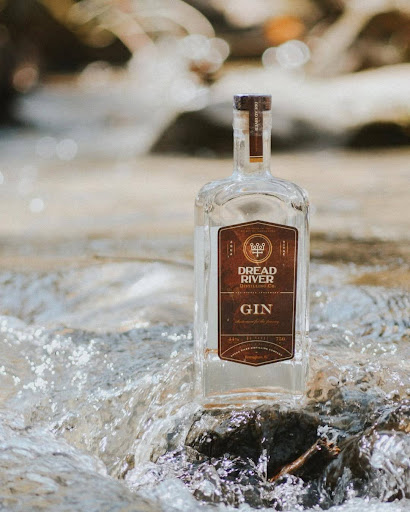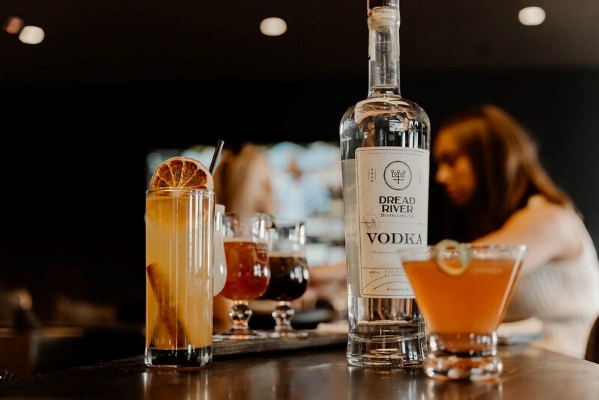Vodka vs. Gin: What’s the Real Difference?
May 12, 2025
Dread River

The argument over gin against vodka goes beyond simple preference to our connection to taste, history, and discovery. Although they start as unassuming spirits, their paths sharply vary. Gin honors its botanical core by its name, which comes from ‘Genever’, the Dutch term for juniper, whereas vodka is meant to have no flavor and therefore praised for its purity.
In this blog, we will explore everything that distinguishes gin from vodka and probe into what the real difference is!
The Fundamentals: Defining Gin & Vodka
What is Vodka?
Though modern versions run from grapes to whey, vodka is the epitome of distillation purity – a clear spirit historically produced from fermented grains or potatoes. The term itself derives from the Slavic word “voda,” meaning water, an apt description for a spirit prized for its transparent character.
What is Gin?
Conversely, gin starts similarly but follows a very different route. Like vodka, it starts as a neutral grain spirit, but from there takes a remarkable journey through the addition of juniper berries and other botanicals. This vital difference imparts gin with its distinctive flavor profile that has pleased palates for centuries.
The legal definition of gin requires the predominant flavor to be juniper, but beyond this fundamental requirement lies a universe of creative possibility. From citrus-led brightness of some modern style to earthy richness of the traditional London Dry formulas, gin provides a botanical tapestry that can metaphorically transport the consumer to the forest floor, spice bazaars, or Mediterranean groves bathed in sunlight.
Learn more about spirit taxonomy and definitions.

The Alchemical Process: Production Methods Unveiled
Vodka’s Path to Purity
The production of vodka is distillation at its purest. The process begins with the fermentation of starch-rich base ingredients—traditionally rye, wheat, corn, or potatoes—to create a mash. This mash ferments as yeast breaks down sugars into alcohol, producing a liquid of relatively low alcoholic strength.
The actual craftsmanship takes place during distillation, where vodka is usually passed through column or pot stills several times to obtain progressively higher purity. With each distillation, impurities are eliminated and the alcoholic content becomes more concentrated. Premium vodkas may be distilled five or more times before undergoing filtration through activated charcoal, silver, or other materials designed to remove remaining congeners.
The water used for proofing the final spirit plays a crucial role in determining character, with a lot of distilleries positioning their pure water origins as central competitive advantages. Vodka rests briefly before getting bottled after filtration and distillation processes.
Gin’s Botanical Infusion
Production of gin takes vodka’s precedent but adds an essential aromatic element. Distillers make a neutral base spirit in the same way as vodka before adding juniper berries and complementary botanicals with one of a variety of methods:
Each method yields distinctive results, tending to create lighter, more floral notes, whereas steeping yields stronger, richly integrated botanical flavor profiles. The choice, amount, and preparation of botanicals are highly secreted practices among master distillers and determine each brand’s signature flavor profile.
- Steeping Process: Botanicals are macerated directly within the spirit so that their flavor compounds and essential oils can be extracted into the liquid prior to redistillation.
- Compound Method: Used less frequently in high-end products, this technique is merely combining botanical extracts with the base spirit without redistillation.
All methods produce unique results, with vapor infusion typically creating lighter, more floral notes, and steeping producing fuller, deeply ingrained botanical flavor. The choice, amount, and processing of botanicals are closely held secrets among master distillers, determining each brand’s signature profile.
Learn more about the distillation methods of Dead River Distillery.
The Sensory Experience: Flavor Profiles Compared
Vodka’s Subtle Symphony
While routinely characterized merely as “neutral,” prime vodka boasts a nuanced personality that repays careful tasting. The initial ingredient lends subtle variation—potato vodkas tend to have a richer feel on the palate with notes of earth, whole grain-based variants might provide subtle sweetness or a peppery finish.
The texture of vodka—its viscosity and how it coats the palate. lies perhaps in its most unique sensory aspect. Super-premium vodkas ought to have a clear start with little or no burn, a velvety middle, and a crisp, snappy finish that leaves the tongue clean, rather than overrun.

Vodka shows its most classy side when properly chilled; this is also the case with temperature, which tones down any remaining roughness while highlighting textural complexities.
Gin’s Botanical Ballet
Gin gives an aromatic voyage starting even before the first drink; whisky, in contrast, has one note. The juniper-forward character presents coniferous notes reminiscent of forest walks—resinous, slightly citric, with an unmistakable pine-like quality that anchors the spirit. Beyond this foundational element, gins can be seen to feature:
- Sharp citrus aroma from lemon, orange, and grapefruit peels.
- Warming spice notes from cinnamon, coriander, or cardamom.
- floral qualities from rose petals, lavender, or chamomile
- Earthly notes of licorice, orris, or angelica root
When considering what is the difference between vodka and gin, this sensory contrast represents perhaps the most immediately apparent distinction for the discerning palate. The intersection of these botanicals creates intricate harmony, with various notes appearing as the spirit travels across the palate. The juniper backbone provides structure while permitting other botanicals to take center stage in a meticulously coordinated sequence of flavor.
Want to know how gin is made and distilled? Check this out!
Cocktail Artistry: Finding Your Perfect Pour
Vodka’s neutrality makes it the chameleon of the spirits world == Vodka’s neutrality makes it the chameleon of the spirits world :
Classic Vodka Martini
The epitome of sophistication, marrying vodka with a touch of dry vermouth and possibly a lemon twist, highlighting the spirit’s crisp character.
Moscow Mule
A revitalizing combination of vodka, spicy ginger beer, and lime juice served in a distinctive copper mug that has had sustained popularity.
Bloody Mary
Married with tomato juice and a sophisticated mix of garnishes and spices, vodka is the quintessential brunch beverage.

The potency of vodka to impart the mildest textural properties and alcohol strength without overweening the surrounding elements is what links these different uses. This characteristic makes it especially useful in cocktails with sensitive tastes that could be drowned by more assertive spirits.
Gin’s Bold Expression
Though in a different way from vodka, gin’s botanical character allows it to be both original and versatile. Numerous spirits fans constantly inquire, ‘What is the difference between vodka & gin?’ while constructing their home bar, and the reply begins with these fundamental production principles. Its herbal complexity allows it to stand up to strong tastes while adding fragrance notes that transform simple dishes into elegant ones:
Gin with Tonic
With tonic water’s quinine bitterness complementing gin’s botanicals and citrus garnishes highlighting particular taste notes, this could be the best symbiotic mix in mixology.
Negroni
A sophisticated balance of gin, sweet vermouth, and Campari produces an ideal balance between sweet, bitter, and herbal notes.
French 75
A sophisticated, festive cocktail made of gin, lemon juice, sugar, and champagne and a fussy holiday mix.
Find innovative cocktail recipes from The Spruce Eats
Making Your Selection: The Essence of Choice
‘What is the difference between vodka and gin?’ ultimately comes down to your personal flavor preferences and intended applications. If botanicals’ complexity is your siren song, gin will entice you. If you want an untouched base that promotes other ingredients, vodka has unparalleled adaptability. The most progressive strategy? Have both, seeing the supporting roles they play within the cocktail world and in your stash.
Embark on a Bold Frontier of Flavor
Embark on a journey beyond ordinary spirits. At Dread River Distilling Co., we don’t just craft premium vodka and gin—we forge liquid adventures that capture Birmingham’s pioneering spirit. Our small-batch craftsmanship turns centuries-old traditions into trailblazing expressions that command to be savored.
Whether you feel like sipping a silky vodka martini or a light and crisp gin and tonic, both spirits have something to delight in. Both can provide a unique canvas for artistic flair, one that can turn the mundane into the sublime.
Don’t merely drink—discover. Explore our collection today and chart your own course through the extraordinary landscape of craft spirits.